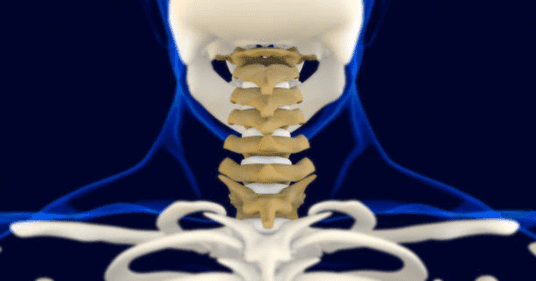Anterior Cervical Discectomy and Fusion (ACDF) surgery is a standard procedure for alleviating chronic neck pain. It also addresses neurological symptoms caused by compressed nerves in the cervical spine.
Dr. Gurneet Singh Sawhney, one of the best neurosurgeon in Mumbai explains:
ACDF surgery is highly effective for treating conditions like a herniated disc in the neck, degenerative disc disease, and spinal stenosis. It involves removing a damaged disc to relieve pressure on the spinal cord or nerve roots. After the damaged disc removal, the surgeon fuses the adjacent vertebrae to stabilize the spine.
However, despite the initial success, some patients may experience neck pain months after the surgery. Experiencing neck pain 1 year after ACDF surgery can be concerning and frustrating for many patients.
Is It Normal To Have Neck Pain 1 Year After ACDF Surgery?
Most patients recover without long-term pain. But, it’s not uncommon for some patients to experience mild neck pain 1 year after ACDF surgery. Ongoing or severe pain could indicate underlying issues. To rule out complications, a healthcare provider should evaluate prolonged pain after this period.
Dr. Gurneet Singh Sawhney, a qualified neurosurgeon in Mumbai, says:
“Persistent pain does not necessarily indicate a failure of the ACDF neck surgery. But it would be best if you did not ignore the symptoms. Addressing it promptly can help avert possible complications and improve quality of life and functionality.”

Are you struggling with neck pain 1 year after your anterior cervical fusion surgery? consult a seasoned neurosurgeon to assess the situation and determine if further treatment is necessary.
How Long Does Neck Pain Last After ACDF Surgery?
The duration of neck pain after ACDF surgery varies widely among patients. Significant pain relief occurs within the first few months post-surgery. It’s a healing time for your body when the vertebrae begin to fuse. However, some patients may experience residual pain for a more extended period, depending on:
- The severity of the original condition
- The specific surgical technique used
- Individual healing processes
Most patients see a substantial decrease in pain 6 months after acdf surgery. Full recovery can take up to a year or more. Consistent follow-up care and adherence to rehabilitation guidelines are vital for optimal recovery.
Causes Of Neck Pain 1 Year After ACDF Surgery
Potential causes of neck fusion surgery include disease progression and surgical or anatomical complications.
Adjacent Segment Disease
Adjacent Segment Disease occurs when vertebrae next to a fusion site degenerate. The degeneration leads to increased stress and potential pain. This condition can manifest as the spine compensates for the reduced mobility at the fused segment. If it is symptomatic and affects the patient’s quality of life, further intervention may be necessary.
Scar Tissue Formation

Scar tissue from the surgical site might impact nearby nerves or restrict neck movements, causing pain. This fibrous tissue usually develops as part of the natural healing process. Occasionally, it can become problematic if it tightens around nerves. Such restrictive formation can lead to discomfort or limited flexibility in the neck area.
Incomplete Fusion
Incomplete fusion, or pseudarthrosis, is when the intended bone fusion fails to solidify. Pseudarthrosis results in instability at the surgical site, causing ongoing pain. Additional surgery may be needed to achieve proper fusion and stability. This procedure will alleviate the discomfort and prevent further spinal deterioration.
Hardware Complications
Hardware complications such as loosening, breakage, or migration of screws and plates used in ACDF surgery can lead to pain. Further surgical intervention might be necessary to replace or remove the hardware. This is particularly important if the hardware irritates the surrounding tissues or impinges on nerves.
Residual Nerve Compression
Residual nerve compression can occur if:
- Nerves did not fully decompress during the initial surgery
- If new compression develops due to scar tissue, hardware issues, or adjacent segment degeneration
Ongoing nerve pain can manifest as sharp pains, numbness, or weakness extending into the arms.
Experiencing neck pain after ACDF surgery? Don’t wait. Contact us today for a consultation and find relief.
Preventive Measures To Avoid Neck Pain 1 Year After The Surgery
Preventing neck pain 1 year after ACDF surgery requires a proactive approach. Here are some effective strategies by Dr. Gurneet Singh Sawhney, a certified neurosurgeon in India:
Follow Post-Surgical Instructions
Follow your surgeon’s advice on activity levels, medication and care for the surgical site. Properly managing these aspects helps:
- Minimize complications
- Ensures the best healing environment
- Significantly reduces the risk of prolonged pain after surgery
Engage in Recommended Physical Therapy

Structured exercises help strengthen neck muscles, improve flexibility, and enhance range of motion. Regular sessions with a physical therapist ensures that your recovery after anterior cervical discectomy and fusion progresses optimally. They can help you prevent long-term complications and manage any residual pain.
Avoid Heavy Lifting
Avoid heavy lifting and strenuous activities, as excessive force can strain the neck and disrupt healing. Seek help when needed to prevent additional stress on the neck.
Stay Active
Light walking or gentle stretching can improve blood circulation and promote healing. Keeping active helps maintain muscle strength and endurance, which supports the neck and reduces the likelihood of pain.
Monitor Symptoms
Keep track of any changes in your symptoms. Report persistent or worsening pain to your healthcare provider promptly for proper evaluation and treatment.
Maintain Proper Posture
Properly set up your workspace, sleeping area, and daily activities to help spread your weight evenly and reduce strain. Comfortable chairs, standing desks, and keeping your spine in a neutral position can greatly reduce neck pressure.
Use Supportive Pillows
Choose a supportive pillow that maintains the natural curve of your neck while sleeping.
Stay Hydrated
Drink plenty of water to keep your discs and tissues hydrated and support spinal health.
Manage Stress

Practice stress-relief techniques such as yoga or meditation. Stress can contribute to muscle tension and pain.
Regular Follow-ups
Schedule and attend all follow-up appointments with your surgeon. They can closely monitor your recovery and address any issues early.
When To Consult A Doctor?
Please seek medical advice immediately if:
- You experience intense, continuous pain that does not improve with rest or medication
- You notice new or worsening weakness or numbness in your limbs
- Have difficulty with swallowing or breathing as it could indicate serious complications
- You develop a fever, notice redness, swelling, or drainage at the surgical site
Dr. Gurneet Singh Sawhney, a trusted neurosurgeon in Mumbai, emphasizes:
“Immediate medical attention is crucial if you experience intense pain that doesn’t improve with rest or medication. New or worsening limb weakness or numbness is a red flag and requires prompt evaluation.”
Are you or a loved one living with neck pain 1 year after ACDF surgery? Schedule a consultation with an experienced neurosurgeon without delay. Take proactive steps today to alleviate your pain and enhance your recovery journey.
Conclusion
In conclusion, experiencing neck pain one year after ACDF surgery, though common, can be concerning. Persistent pain doesn’t necessarily mean the surgery failed but can result from factors like adjacent segment disease, scar tissue, incomplete fusion, hardware issues, or residual nerve compression. Understanding these causes helps in finding effective treatments.
If you’re dealing with neck pain a year after ACDF surgery, consult a qualified healthcare provider to evaluate and address your symptoms promptly. Early intervention can prevent complications and enhance your recovery, helping you achieve a pain-free life.
Let’s head to our FAQ section to address some common concerns.
FAQs
How many years does ACDF surgery last?
The benefits of ACDF can last for many years, as the fusion achieved during the surgery is permanent. Studies suggest that outcomes from ACDF surgery can remain effective for over a decade before the possibility of requiring further surgeries arises.
What is the most common complication of ACDF?
Complications may include infection, nerve damage, or issues with the hardware. The most common complication of ACDF surgery is dysphagia or difficulty swallowing. It usually resolves within a few weeks to months post-surgery.
Can I live a normal life after ACDF surgery?
Many patients return to a normal, active lifestyle after recovery. This achievement results from diligent rehabilitation efforts and strict adherence to post-operative instructions.
What are the permanent restrictions after ACDF neck surgery?
Permanent restrictions to prevent strain on the neck and promote long-term spinal health may include:
- Avoiding heavy lifting
- High-impact activities
- Certain neck movements
Reference Links:

